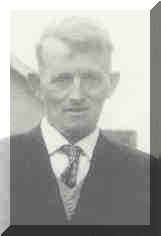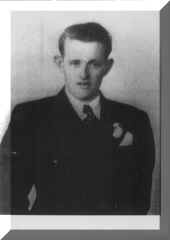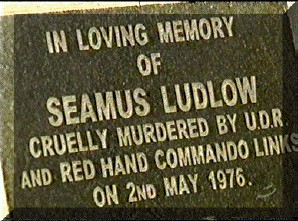The Murder of Seamus Ludlow in County Louth, May 1976. Towards a public inquiry?



The Murder of Seamus Ludlow in County Louth, May 1976. Towards a public inquiry?
|
|
Introduction to the murder of Seamus Ludlow and the official cover-up. Michael Cunningham investigation - 1978 The recent Campaign for Truth and Justice. Irish Victims Commission Report. Ludlow family's questions for the RUC (now the PSNI) Jim J. Kane's letter to the N I Human Rights Commission. Jim J. Kane's letter to the RUC Ludlow Family Letter to Bertie Ahern View messages from our original Guestbook Other Ludlow Family Sites.
|
Ireland on Sunday, 14 February 1999: What's the truth? There are at least three unusual aspects to the brutal murder over 20 years ago of Seamus Ludlow outside Dundalk. Some hard questions will be posed a public inquiry in Dundalk town hall this Thursday night. Anne Cadwallader Seamus Ludlow was a quiet hard-working 47-year-old Co Louth bachelor who lived with his sister and her children until, 23 years ago, he was abducted and murdered by a gang of drunken Loyalists. He shared the fate of many a Catholic in the North over the generations who had the misfortune to fall into the path of armed sectarianism, but a closer examination of the case uncovers far murkier depths. Unusually this is a case where accusations are not just being levelled at the British security establishment. The gardai are firmly in the firing line too. Ludlow was a Catholic and had no connection with any Republican grouping. His body was found by a tourist out for a walk at about 3pm on Sunday, May 2, 1976. He had been shot through the heart, right lung and liver with a .38 revolver. His clean shoes told police he had been killed elsewhere and his body dumped where it was found. Ludlow's photograph shows him as he was: a middle-aged innocent of the "old school", neatly dressed in suit and tie whose only indulgence was a Saturday night drink and game of darts in his home town of Dundalk. It was after an evening spent in this harmless way that, hitching a ride home, he fell into the clutches of a Loyalist gang who shot him dead as he sat defenceless in their car, leaving his body on the side f the road. There are at least three more unusual aspects to Ludlow's brutal murder - questions that will be asked for the first time in public in Dundalk town hall this Thursday night by his friends and family. Firstly, why were the killers, at least two of whom were members of the illegal Red Hand Commando group - an offshoot of the UVF - while also serving soldiers in the Ulster Defence Regiment, never held accountable for the murder? Secondly, and even more sinister, why did the gardai blacken the dead man's name by branding him an informer and blaming the IRA until recently for the death? Why did the gardai drop their inquiry just three weeks after Ludlow died and why have they treated the family such insensitivity over the years? The emerging theory is that at least two of the men who killed Ludlow were double-agents working for British military intelligence and, therefore, "above the law" - free to do as they liked - even if that included killing innocent Catholics. More worrying still is the theory that the same men were also supplying information to the gardai who turned a blind eye to the sectarian murder of an innocent citizen of the Republic. Although these questions cannot now be answered, the extended Ludlow family on both sides of the border is pledged top continue asking them until the police forces in both jurisdictions are held accountable. British/Irish Rights Watch (BIRW), the group that blew open the case of murdered lawyer Pat Finucane, this week is supporting the family's demand for a full inquiry. BIRW has produced a full dossier on the Ludlow case, which can be accessed via the Pat Finucane Centre internet website at http://www.serve.com/pfc What is also unusual about the case, indeed unique, is that an eyewitness to the killing, Loyalist Paul Hosking, has given a public account of exactly how Ludlow met his end. Hosking and three others were arrested and questioned about the murder last year, 22 years later. Papers in the case are now with the North's director of public prosecutions (DPP) awaiting a decision on possible charges. Seamus Ludlow's killing took place during the garda "heavy gang" period of the 1970s. Some members of the Ludlow family see significance in this, believing the tough, anti-Republican law-and-order agenda of that Government played a role in the cover-up after Ludlow's death and the protection of his killers. In the two weeks prior to his death, Loyalists had been particularly active in the south Down and border area, as had the British army which, on April 15, had abducted and murdered IRA suspect, Peter Cleary, 25. On April 24, a week before Ludlow's murder, James Byrne, 63, was killed in a Loyalist pub bombing in Hilltown, south Down and, April 27, Matthew Campbell, 22, a Catholic had been killed in a loyalist bombing of a bar in Warrenpoint, south Down. Ludlow was on his way home from the Lisdoo Arms in Dundalk on May 1 when he was last seen alive by anyone except his killers who - according to Hosking - stopped and gave him a lift. Hosking and the others had been on a day-long drinking spree, which began in Comber and continued south of the border. One of the gang was a captain in the UDR, another was also a member of the regiment. The fourth man was a loyalist from Comber, who, for legal reasons, can only be identified as "M". All three were active in the Red Hand Commando. Hosking had been active on the fringes of the UDA. After stopping to pick up Ludlow, the car stopped again to allow Hosking to relieve himself. As he was doing so, he heard a banging noise and looked over his shoulder to see the killing of Seamus Ludlow taking place. "I swung round and there was this guy "M", sort of half in the car and he was shooting in the car. All I remember then is your man "M" pulling him out and (another man) was pushing him out. "The guy fell on the floor, so they got out and picked him up and threw him onto a hedge, I think it was. Then your man shouted to get in. "I was standing there shocked, I was horrified. My first thought was that they were going to do the same thing to me because I had seen what they had done. I got in the back and the whole way back I just stared out of the window." Ludlow's sister, Nan, began a search for her brother after she woke and got her children ready for 8am Mass. She contacted his two brothers and sisters to see if he had stayed over. He hadn't. A search party was quickly formed. The two walkers found Ludlow's body, which was identified by two brothers-in-law. A massive hunt began for the killers with 1,700 homes visited and 1,000 cars stopped at vehicle checkpoints. Jimmy Sharkey, the dead man's nephew, says the garda attitude to the family was strange almost from the start. "They were very hostile showing no sympathy or compassion. A huge funeral took place on May 5 with an estimated 2,500 in attendance. Within a month, however, the murder inquiry abruptly came to a halt. Individual gardai who were on good terms with the family unaccountably stopped talking to them. By now the gardai were openly telling people that Ludlow had been murdered by the IRA as an informer. The family believe this was part of an orchestrated campaign to discredit Ludlow and divide them. Some family members were even told that their relatives were aware the dead man had been an IRA informer and had colluded in the planned killing. A brother-in-law of the dead man, Kevin Donegan, was visited by the British army the day after Ludlow's funeral at his home in the North and he later went to Forkhill barracks to speak to the RUC. He was airlifted from there to Bessbrook where he was questioned for over an hour - not about the murder but about the garda investigations. There was also a mystery about the timing of the inquest. The gardai called to alert the family only 45 minutes before it was held, far too short a time for any relative to attend. There was no ballistics evidence, no forensic evidence, and only a pathologist's report before the court. The jury returned a verdict of death by gunshot wounds. Twenty years passed, says the family, before a senior garda officer openly admitted that the force had crucial evidence available to them since shortly after Ludlow's murder. Three years after the killing, in February 1979, the RUC furnished the names of the three prime suspects to this senior officer. There is no evidence that the gardai subsequently launched any sort of an inquiry. Hosking, who has openly admitted his role in the killing, while denying any direct involvement, says he was threatened by other members of the gang and told to join the Red Hand Commando group. Two years after the killing he went to live in Scotland - returning to the North in 1986. On his return, he agreed to meet an RUC officer in a pub where he explained for a second time all he knew, but was told to "forget it, it's political". Then on February 17, last year, four men were arrested and questioned about the murder. Hosking again told the police the full story. All four were, however, released without charge. A file was sent to the DPP in October last year. Seamus Ludlow's family wants a full public inquiry into his murder. Why, they ask, did the garda investigation stop after three weeks? Why were the family effectively excluded from the inquest? Why was the RUC information never acted on? Will the gardai apologise for the "IRA informer" smear? Why did the RUC take no action when Hosking told them the whole story in 1987? How far up did the cover-up go? Did it include members of the Cosgrave coalition Government? Were the gardai also involved in the "dirty tricks" of the time, using Loyalist informers and tolerating murder to protect their sources? The Ludlow family wants to know above all if the police and military on both sides of the border are to be held accountable for the life, death and botched inquiry into the death of an innocent 47-year-old man, shot down in cold blood?
I Homepage I I Top I I Press Coverage I
|